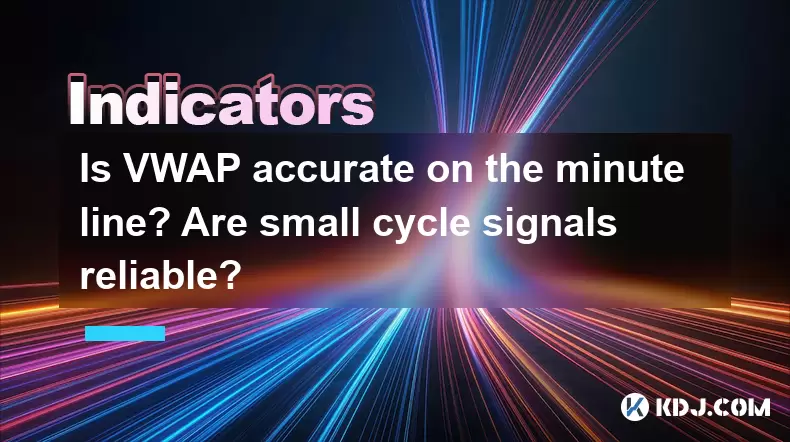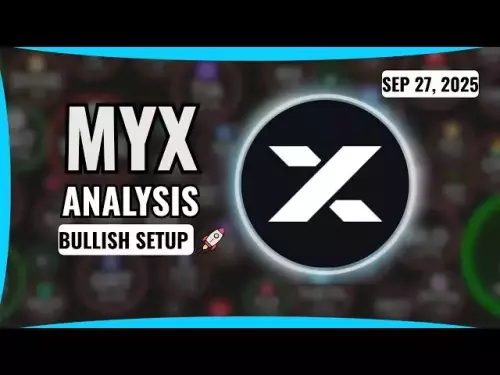-
 bitcoin
bitcoin $109523.663807 USD
-0.13% -
 ethereum
ethereum $4019.526508 USD
2.06% -
 tether
tether $1.000482 USD
0.00% -
 xrp
xrp $2.776815 USD
0.18% -
 bnb
bnb $958.942396 USD
0.12% -
 solana
solana $204.294698 USD
3.84% -
 usd-coin
usd-coin $0.999693 USD
0.00% -
 dogecoin
dogecoin $0.232115 USD
2.09% -
 tron
tron $0.338028 USD
0.84% -
 cardano
cardano $0.790920 USD
1.50% -
 hyperliquid
hyperliquid $44.871443 USD
5.60% -
 ethena-usde
ethena-usde $1.000322 USD
0.04% -
 chainlink
chainlink $21.034165 USD
2.60% -
 avalanche
avalanche $28.794831 USD
-0.54% -
 stellar
stellar $0.360466 USD
1.24%
Is VWAP accurate on the minute line? Are small cycle signals reliable?
VWAP on the minute line can be less accurate due to limited data, leading to higher volatility and less reliable signals; traders should use additional indicators for confirmation.
May 21, 2025 at 07:14 pm

Understanding VWAP and Its Accuracy on the Minute Line
Volume Weighted Average Price (VWAP) is a trading benchmark used especially in the stock and cryptocurrency markets to gauge the average price at which a security has traded throughout the day, based on both volume and price. It is a critical tool for traders looking to execute trades at favorable prices. When it comes to the accuracy of VWAP on the minute line, it's essential to understand that VWAP is calculated using cumulative data, which means it updates with each new trade.
On the minute line, VWAP can be less accurate than on longer time frames due to the limited amount of data available within a single minute. This short time frame can lead to higher volatility and less reliable signals. Traders should be cautious when using minute-by-minute VWAP because the data might not be as comprehensive as that on longer intervals, such as hourly or daily charts.
The Mechanics of VWAP Calculation on Short Intervals
Calculating VWAP on a minute-by-minute basis involves a continuous update of the formula. Here's how it works:
- Cumulative Volume: The total volume of trades up to the current minute.
- Cumulative Turnover: The total value of trades up to the current minute.
- VWAP Formula: VWAP = Cumulative Turnover / Cumulative Volume.
On a minute line, these values are recalculated every minute, which can lead to rapid changes in the VWAP line. This can be both an advantage and a disadvantage. On one hand, it provides real-time data that can be useful for very short-term trading strategies. On the other hand, the constant recalculations can lead to false signals if the market is highly volatile within that minute.
Reliability of Small Cycle Signals
Small cycle signals, such as those derived from minute-by-minute data, can be less reliable due to the inherent volatility and noise present in such short time frames. These signals are often influenced by market noise, which includes random fluctuations that do not necessarily reflect the true market trend.
Traders should be aware that while small cycle signals can provide insights into immediate market movements, they are more prone to false breakouts and whipsaws. This means that a trader might enter or exit a position based on a signal that turns out to be misleading. Therefore, it's crucial to use additional indicators or longer time frames to confirm these signals before making trading decisions.
Using VWAP on the Minute Line: Practical Considerations
When using VWAP on a minute-by-minute basis, traders need to consider several practical aspects to maximize its effectiveness and minimize risks. Here are some key considerations:
- Volatility: Minute-by-minute VWAP is more sensitive to sudden price changes. Traders should be prepared for rapid shifts in the VWAP line.
- Confirmation: Use other technical indicators, such as moving averages or RSI, to confirm signals derived from minute-by-minute VWAP.
- Risk Management: Given the potential for false signals, implement tight stop-loss orders to manage risk effectively.
Strategies for Trading with Minute-by-Minute VWAP
Traders can employ several strategies when using VWAP on the minute line. Here are some approaches:
- Scalping: This involves making numerous small trades throughout the day to profit from minute-by-minute price movements. Traders using this strategy often look for moments when the price crosses the VWAP line to enter or exit trades.
- Breakout Trading: Traders can use minute-by-minute VWAP to identify potential breakouts. If the price moves significantly away from the VWAP, it might indicate a strong trend, but confirmation with other indicators is crucial.
- Mean Reversion: Some traders believe that prices will eventually return to the VWAP line. They might enter trades when the price is significantly above or below the VWAP, expecting it to revert to the mean.
Limitations and Challenges of Using VWAP on Short Time Frames
While VWAP can be a powerful tool, there are several limitations and challenges when using it on short time frames like the minute line:
- Data Quality: The quality of data on a minute-by-minute basis can be affected by low liquidity or erratic trading volumes, leading to less reliable VWAP calculations.
- Market Noise: Short-term fluctuations can create noise that obscures the true market trend, making it difficult to distinguish between meaningful signals and random movements.
- Execution Risk: The rapid changes in VWAP on the minute line can lead to execution risks, where traders might not be able to enter or exit positions at the desired price due to the speed of market movements.
Enhancing the Accuracy of VWAP on Short Intervals
To enhance the accuracy of VWAP on the minute line, traders can adopt several techniques:
- Filtering: Use filters to smooth out the VWAP line, reducing the impact of short-term volatility. This can be achieved by applying moving averages to the VWAP itself.
- Combining Indicators: Use VWAP in conjunction with other indicators, such as Bollinger Bands or MACD, to get a more comprehensive view of market conditions.
- Volume Analysis: Pay attention to volume patterns. High volumes can validate the signals derived from minute-by-minute VWAP, while low volumes might indicate less reliable signals.
Case Studies: Real-World Applications of VWAP on the Minute Line
To illustrate the practical use of VWAP on the minute line, let's look at a couple of case studies:
- Case Study 1: A trader uses minute-by-minute VWAP to scalp Bitcoin. They notice that the price of Bitcoin frequently reverts to the VWAP line after brief deviations. By entering trades when the price moves away from the VWAP and exiting when it returns, the trader aims to profit from these small movements.
- Case Study 2: Another trader uses minute-by-minute VWAP to identify breakout opportunities in Ethereum. They observe that when the price of Ethereum moves significantly above the VWAP, it often signals the start of a strong uptrend. The trader uses this information to enter long positions and uses other indicators to confirm the breakout.
FAQs
Q1: Can VWAP be used effectively for long-term trading strategies on the minute line?A1: While VWAP can be used for short-term trading on the minute line, it is generally less effective for long-term strategies due to the high volatility and noise associated with such short intervals. Long-term traders typically use VWAP on longer time frames, such as daily or weekly charts, to get a more stable and reliable indicator of average price.
Q2: How can traders mitigate the risks associated with using VWAP on the minute line?A2: To mitigate risks, traders should use additional technical indicators to confirm signals, implement strict risk management practices such as stop-loss orders, and be aware of the potential for false breakouts and whipsaws. Additionally, understanding the market's liquidity and volume patterns can help in assessing the reliability of VWAP signals on short time frames.
Q3: Is it possible to automate trading strategies based on VWAP on the minute line?A3: Yes, it is possible to automate trading strategies using VWAP on the minute line. Many trading platforms offer tools and APIs that allow traders to develop and implement automated strategies. However, traders should thoroughly backtest their strategies to ensure they are robust and can handle the volatility and noise inherent in minute-by-minute data.
Q4: How does the accuracy of VWAP on the minute line compare to other technical indicators?A4: The accuracy of VWAP on the minute line can vary compared to other technical indicators. While VWAP provides a volume-weighted average, other indicators like moving averages or RSI might offer different insights into price trends and momentum. VWAP's accuracy on the minute line can be less reliable due to short-term volatility, but when combined with other indicators, it can enhance a trader's overall analysis.
Disclaimer:info@kdj.com
The information provided is not trading advice. kdj.com does not assume any responsibility for any investments made based on the information provided in this article. Cryptocurrencies are highly volatile and it is highly recommended that you invest with caution after thorough research!
If you believe that the content used on this website infringes your copyright, please contact us immediately (info@kdj.com) and we will delete it promptly.
- Bitcoin, mNAV, and Treasury Companies: A New York Perspective
- 2025-09-28 04:25:14
- BNB Price and the Rise of BlockchainFX: The Crypto Presale to Watch
- 2025-09-28 04:25:14
- Trump, WLFI, and the Token Burn: Can Burning Crypto Make it Great Again?
- 2025-09-28 04:45:15
- James Wynn's 3x Leveraged Crypto Gamble: ASTER Airdrop or Bust?
- 2025-09-28 04:45:15
- Frank Zappa's 'One Size Fits All' Turns 50: Still the Perfect Fit?
- 2025-09-28 04:50:11
- Bitcoin Miners Pivot: TeraWulf and the AI Data Center Gold Rush
- 2025-09-28 04:30:01
Related knowledge

What is a tower bottom candlestick pattern? Does it have a high success rate?
Sep 22,2025 at 07:18am
Tower Bottom Candlestick Pattern Explained1. The tower bottom candlestick pattern is a reversal formation that typically appears at the end of a downt...

What is a black hole pattern in the MACD indicator? Is it a cause for concern?
Sep 21,2025 at 06:54pm
Bitcoin's Role in Decentralized Finance1. Bitcoin remains the cornerstone of decentralized finance, serving as a benchmark for value and security acro...

How can I use the psychological line (PSY) to determine market sentiment?
Sep 17,2025 at 02:19pm
Understanding the Psychological Line (PSY) in Cryptocurrency TradingThe Psychological Line, commonly referred to as PSY, is a momentum oscillator used...

How can I determine if a double top pattern has officially formed?
Sep 21,2025 at 03:18am
Understanding the Structure of a Double Top Pattern1. A double top pattern consists of two distinct peaks that reach approximately the same price leve...

What is the Golden Valley pattern on the moving average? Is it better than the Silver Valley pattern?
Sep 21,2025 at 02:54pm
Understanding the Golden Valley Pattern in Moving Averages1. The Golden Valley pattern is a technical formation observed in cryptocurrency price chart...

What does a death cross of the RSI in the strong zone (above 50) mean?
Sep 17,2025 at 10:54pm
Understanding the Death Cross in RSI Context1. The term 'death cross' is traditionally associated with moving averages, where a short-term average cro...

What is a tower bottom candlestick pattern? Does it have a high success rate?
Sep 22,2025 at 07:18am
Tower Bottom Candlestick Pattern Explained1. The tower bottom candlestick pattern is a reversal formation that typically appears at the end of a downt...

What is a black hole pattern in the MACD indicator? Is it a cause for concern?
Sep 21,2025 at 06:54pm
Bitcoin's Role in Decentralized Finance1. Bitcoin remains the cornerstone of decentralized finance, serving as a benchmark for value and security acro...

How can I use the psychological line (PSY) to determine market sentiment?
Sep 17,2025 at 02:19pm
Understanding the Psychological Line (PSY) in Cryptocurrency TradingThe Psychological Line, commonly referred to as PSY, is a momentum oscillator used...

How can I determine if a double top pattern has officially formed?
Sep 21,2025 at 03:18am
Understanding the Structure of a Double Top Pattern1. A double top pattern consists of two distinct peaks that reach approximately the same price leve...

What is the Golden Valley pattern on the moving average? Is it better than the Silver Valley pattern?
Sep 21,2025 at 02:54pm
Understanding the Golden Valley Pattern in Moving Averages1. The Golden Valley pattern is a technical formation observed in cryptocurrency price chart...

What does a death cross of the RSI in the strong zone (above 50) mean?
Sep 17,2025 at 10:54pm
Understanding the Death Cross in RSI Context1. The term 'death cross' is traditionally associated with moving averages, where a short-term average cro...
See all articles









































































